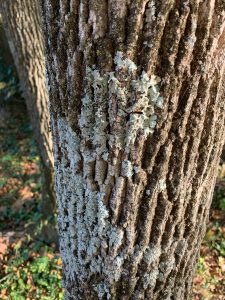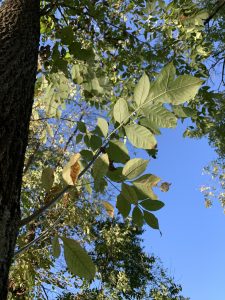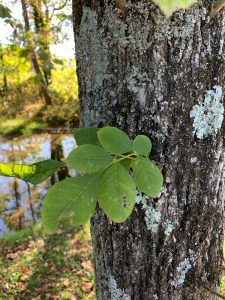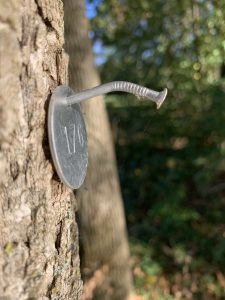10/14/19
Arrived: 4:30 Left: 5:15 Time Spent: 45 mins
I selected a medium-sized tree at my sit spot. Most of the trees in my sit spot I can identify, especially because many of them are sycamores, so I wanted to identify a new type of tree. This tree is on the outskirts of my sit spot closer to the footbridge than I usually sit when I am observing. I identified it as a Green Ash tree. I also selected it because I knew I wanted to choose a tree and it was one of the few without vines which I’ve learned recently are likely to be poison ivy. As a side note, I’m from Maine and thought myself pretty good at identifying poison ivy. The difference is it is only on the ground in Maine as a small plant, I have never seen it growing as a vine. It was humbling because I almost touched it in my examination even knowing what poison ivy looks like. I do not think I got anyone me but I guess I will find out in the next few days or hours to come.
This particular tree does not have a particularly large diameter. I would say it is a medium-sized deciduous tree. It had definitely begun dropping leaves and I actually think the top part of it may have been dead because it had dropped a disproportionate number of leaves. The trunk of the tree looked healthy and was sort of an ashy brown color. The trunk also had lichen and tiny spider webs all over it. It was so cool to see so many symbiotic relationships on just one tree. The leaves ranged from two or three inches long to maybe six or seven inches long. They were oblong and had a pointed end.
I found that ash trees in general but also specifically green ash are valued in making things like the handles of tools. It is also a common wood in making baseball or softball bats. I also found that these trees can survive in areas that flood up to 40% of the time so it makes even more sense that I found it right next to the stream which frequently floods.
I looked for a reliable source, some sort of tree index and stumbled upon an ID guide from the Forestry Department of Virginia. Then I sort of went to the index using pictures of the leaves from my tree and eventually came to ash trees. After looking at the different options the Green Ash seemed the most fitting. Also, the bark description and diagrams matched what I had observed perfectly. I enjoyed the process of identifying it. I have done work with identifying other tree species, so I just followed steps that had been helpful in the past, such as focusing on the leaves.
I can not decide if I like taking notes in real-time more or less then taking time to observe and then taking notes. I feel like my notes are more detailed in real-time but that I maybe do not notice as much. I think both methods have their pros and cons. I liked focusing on one specific thing for thirty minutes rather than observing a whole area because I was able to give more detail and think more critically about what I was observing.
As an added bonus I saw another crawfish. This has nothing to do with my Species Summary, but I have managed to see one every time I have gone to my sit spot and wanted to include it. This particular crawfish was extremely easy to see, I saw him at first glance into the stream.








I like your blog! I like how you added those fun facts about what ash wood is popularly used for. Also, I really hope you don’t get a reaction from Poison Ivy.
I really enjoyed reading your blog. That’s really cool that they use the wood from the tree you observed to make baseball bats!